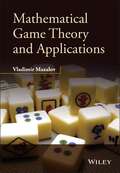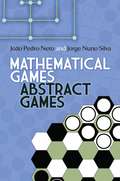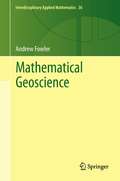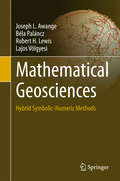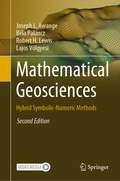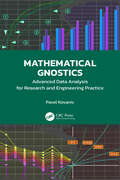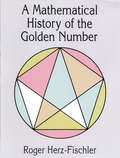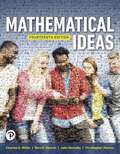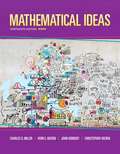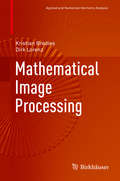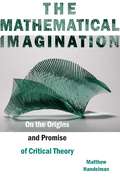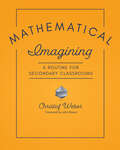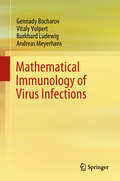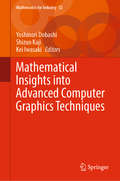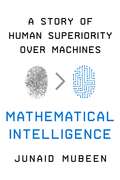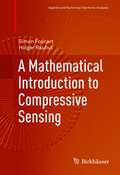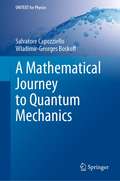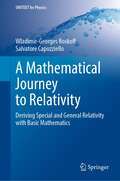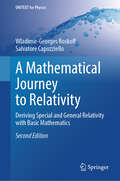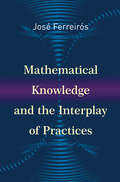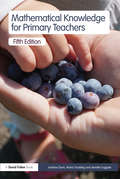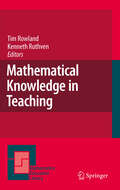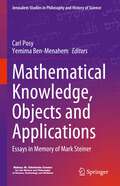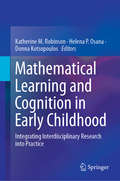- Table View
- List View
Mathematical Game Theory and Applications: Game-theoretic Models In Mathematical Ecology (Game Theory And Applications Ser.)
by Vladimir MazalovAn authoritative and quantitative approach to modern game theory with applications from economics, political science, military science, and finance Mathematical Game Theory combines both the theoretical and mathematical foundations of game theory with a series of complex applications along with topics presented in a logical progression to achieve a unified presentation of research results. This book covers topics such as two-person games in strategic form, zero-sum games, N-person non-cooperative games in strategic form, two-person games in extensive form, parlor and sport games, bargaining theory, best-choice games, cooperative games and dynamic games. Several classical models used in economics are presented which include Cournot, Bertrand, Hotelling, and Stackelberg as well as coverage of modern branches of game theory such as negotiation models, potential games, parlor games, and best choice games. Mathematical Game Theory: • Presents a good balance of both theoretical foundations and complex applications of game theory. • Features an in-depth analysis of parlor and sport games, networking games, and bargaining models. • Provides fundamental results in new branches of game theory, best choice games, network games, and dynamic games. • Presents numerous examples and exercises along with detailed solutions at the end of each chapter. • Is supported by an accompanying website featuring course slides and lecture content. Covering a host of important topics, this book provides a research springboard for graduate students and a reference for researchers who might be working in the areas of applied mathematics, operations research, computer science, or economical cybernetics.
Mathematical Games, Abstract Games
by Jorge Nuno Silva Joao Pedro NetoPerfect for those who enjoy intellectual challenges, this user-friendly and visually appealing collection offers both new and classic strategic board games. Chapters include two- and three-player games, a selection of mathematical games that features Nim and games on graphs, a survey of the theory and history of board games, and a lengthy glossary.
Mathematical Geoscience
by Andrew FowlerMathematical Geoscience is an expository textbook which aims to provide a comprehensive overview of a number of different subjects within the Earth and environmental sciences. Uniquely, it treats its subjects from the perspective of mathematical modelling with a level of sophistication that is appropriate to their proper investigation. The material ranges from the introductory level, where it can be used in undergraduate or graduate courses, to research questions of current interest. The chapters end with notes and references, which provide an entry point into the literature, as well as allowing discursive pointers to further research avenues. The introductory chapter provides a condensed synopsis of applied mathematical techniques of analysis, as used in modern applied mathematical modelling. There follows a succession of chapters on climate, ocean and atmosphere dynamics, rivers, dunes, landscape formation, groundwater flow, mantle convection, magma transport, glaciers and ice sheets, and sub-glacial floods. This book introduces a whole range of important geoscientific topics in one single volume and serves as an entry point for a rapidly expanding area of genuine interdisciplinary research. By addressing the interplay between mathematics and the real world, this book will appeal to graduate students, lecturers and researchers in the fields of applied mathematics, the environmental sciences and engineering.
Mathematical Geosciences
by Joseph L. Awange Béla Paláncz Robert H. Lewis Lajos VölgyesiThis book showcases powerful new hybrid methods that combine numerical and symbolic algorithms. Hybrid algorithm research is currently one of the most promising directions in the context of geosciences mathematics and computer mathematics in general. One important topic addressed here with a broad range of applications is the solution of multivariate polynomial systems by means of resultants and Groebner bases. But that’s barely the beginning, as the authors proceed to discuss genetic algorithms, integer programming, symbolic regression, parallel computing, and many other topics.The book is strictly goal-oriented, focusing on the solution of fundamental problems in the geosciences, such as positioning and point cloud problems. As such, at no point does it discuss purely theoretical mathematics. "The book delivers hybrid symbolic-numeric solutions, which are a large and growing area at the boundary of mathematics and computer science." Dr. Daniel Lichtbau
Mathematical Geosciences: Hybrid Symbolic-Numeric Methods
by Joseph L. Awange Béla Paláncz Robert H. Lewis Lajos VölgyesiThis second edition of Mathematical Geosciences book adds five new topics: Solution equations with uncertainty, which proposes two novel methods for solving nonlinear geodetic equations as stochastic variables when the parameters of these equations have uncertainty characterized by probability distribution. The first method, an algebraic technique, partly employs symbolic computations and is applicable to polynomial systems having different uncertainty distributions of the parameters. The second method, a numerical technique, uses stochastic differential equation in Ito form; Nature Inspired Global Optimization where Meta-heuristic algorithms are based on natural phenomenon such as Particle Swarm Optimization. This approach simulates, e.g., schools of fish or flocks of birds, and is extended through discussion of geodetic applications. Black Hole Algorithm, which is based on the black hole phenomena is added and a new variant of the algorithm code is introduced and illustrated based on examples; The application of the Gröbner Basis to integer programming based on numeric symbolic computation is introduced and illustrated by solving some standard problems; An extension of the applications of integer programming solving phase ambiguity in Global Navigation Satellite Systems (GNSSs) is considered as a global quadratic mixed integer programming task, which can be transformed into a pure integer problem with a given digit of accuracy. Three alternative algorithms are suggested, two of which are based on local and global linearization via McCormic Envelopes; and Machine learning techniques (MLT) that offer effective tools for stochastic process modelling. The Stochastic Modelling section is extended by the stochastic modelling via MLT and their effectiveness is compared with that of the modelling via stochastic differential equations (SDE). Mixing MLT with SDE also known as frequently Neural Differential Equations is also introduced and illustrated by an image classification via a regression problem.
Mathematical Gnostics: Advanced Data Analysis for Research and Engineering Practice
by Pavel KovanicThe book describes the theoretical principles of nonstatistical methods of data analysis but without going deep into complex mathematics. The emphasis is laid on presentation of solved examples of real data either from authors' laboratories or from open literature. The examples cover wide range of applications such as quality assurance and quality control, critical analysis of experimental data, comparison of data samples from various sources, robust linear and nonlinear regression as well as various tasks from financial analysis. The examples are useful primarily for chemical engineers including analytical/quality laboratories in industry, designers of chemical and biological processes. Features: Exclusive title on Mathematical Gnostics with multidisciplinary applications, and specific focus on chemical engineering. Clarifies the role of data space metrics including the right way of aggregation of uncertain data. Brings a new look on the data probability, information, entropy and thermodynamics of data uncertainty. Enables design of probability distributions for all real data samples including smaller ones. Includes data for examples with solutions with exercises in R or Python. The book is aimed for Senior Undergraduate Students, Researchers, and Professionals in Chemical/Process Engineering, Engineering Physics, Stats, Mathematics, Materials, Geotechnical, Civil Engineering, Mining, Sales, Marketing and Service, and Finance.
A Mathematical History of the Golden Number
by Roger Herz-FischlerThe first complete, in-depth study of the origins of division in extreme and mean ratio (DEMR)-"the Golden Number"-this text charts every aspect of this important mathematical concept's historic development, from its first unequivocal appearance in Euclid's Elements through the 18th century.Readers will find a detailed analysis of the role of DEMR in the Elements and of its historical implications. This is followed by a discussion of other mathematical topics and of proposals by modern commentators concerning the relationship of these concepts to DEMR. Following chapters discuss the Pythagoreans, examples of the pentagram before 400 H.C., and the writings of pre-Euclidean mathematicians. The author then presents his own controversial views on the genesis, early development and chronology of DEMR. The second half of the book traces DEMR's post-Euclidean development through the later Greek period, the Arabic world, India, and into Europe. The coherent but rigorous presentation places mathematicians' work within the context of their time and dearly explains the historical transmission of their results. Numerous figures help clarify the discussions, a helpful guide explains abbreviations and symbols, and a detailed appendix defines terminology for DEMR through the ages.This work will be of interest not only to mathematicians but also to classicists, archaeologists, historians of science and anyone interested in the transmission of mathematical ideas. Preface to the Dover Edition. Foreword. A Guide for Readers. Introduction. Appendixes. Corrections and Additions. Bibliography.
Mathematical Ideas
by John Hornsby Christopher Heeren Charles Miller Vern HeerenFor courses in Liberal Arts Mathematics. Engages non-STEM students with a practical presentation that connects mathematics to their current and future lives Mathematical Ideasis a versatile text that has evolved to meet changing curricular needs and trends, but remains steadfast to its primary objectives - comprehensive coverage, appropriate organization, clear exposition, abundant examples, and well-planned exercise sets with numerous applications. With a fresh focus on math in the workplace, this program shows students in liberal arts and survey courses how math will play an important role in their futures, while helping them to develop a solid understanding of mathematical concepts. The 14th Edition updates and enhances the text's hallmark features, and expands its robust MyLabTM Math course to include StatCrunch(R) applets, animations, corequisite course material, new section lecture videos, and much more. Also available with MyLab Math MyLab Math is the teaching and learning platform that empowers you to reach every student. By combining trusted author content with digital tools and a flexible platform, MyLab Math personalizes the learning experience and improves results for each student. Learn more about MyLab Math. Note: You are purchasing a standalone product; MyLab Math does not come packaged with this content. Students, if interested in purchasing this title with MyLab Math, ask your instructor to confirm the correct package ISBN and Course ID. Instructors, contact your Pearson representative for more information.
Mathematical Ideas
by Charles Miller Vern Heeren John Hornsby Christopher HeerenA mathematical textbook
Mathematical Ideas (Thirteenth Edition)
by Charles D. Miller Vern E. Heeren John E. Hornsby Christopher HeerenMathematical Ideas 13/e, captures the interest of non-majors who take the Liberal Arts Math course by showing how mathematics plays an important role in everyday life. With a fresh, new focus on math in the workplace, this program shows students how math will play an important role in their future, while encouraging them to understand and embrace the mathematical concepts.
Mathematical Image Processing (Applied and Numerical Harmonic Analysis)
by Kristian Bredies Dirk LorenzThis book addresses the mathematical aspects of modern image processing methods, with a special emphasis on the underlying ideas and concepts. It discusses a range of modern mathematical methods used to accomplish basic imaging tasks such as denoising, deblurring, enhancing, edge detection and inpainting. In addition to elementary methods like point operations, linear and morphological methods, and methods based on multiscale representations, the book also covers more recent methods based on partial differential equations and variational methods.Review of the German Edition: The overwhelming impression of the book is that of a very professional presentation of an appropriately developed and motivated textbook for a course like an introduction to fundamentals and modern theory of mathematical image processing. Additionally, it belongs to the bookcase of any office where someone is doing research/application in image processing. It has the virtues of a good and handy reference manual. (zbMATH, reviewer: Carl H. Rohwer, Stellenbosch)
The Mathematical Imagination: On the Origins and Promise of Critical Theory
by Matthew HandelmanThis book offers an archeology of the undeveloped potential of mathematics for critical theory. As Max Horkheimer and Theodor W. Adorno first conceived of the critical project in the 1930s, critical theory steadfastly opposed the mathematization of thought. Mathematics flattened thought into a dangerous positivism that led reason to the barbarism of World War II. The Mathematical Imagination challenges this narrative, showing how for other German-Jewish thinkers, such as Gershom Scholem, Franz Rosenzweig, and Siegfried Kracauer, mathematics offered metaphors to negotiate the crises of modernity during the Weimar Republic. Influential theories of poetry, messianism, and cultural critique, Handelman shows, borrowed from the philosophy of mathematics, infinitesimal calculus, and geometry in order to refashion cultural and aesthetic discourse.Drawn to the austerity and muteness of mathematics, these friends and forerunners of the Frankfurt School found in mathematical approaches to negativity strategies to capture the marginalized experiences and perspectives of Jews in Germany. Their vocabulary, in which theory could be both mathematical and critical, is missing from the intellectual history of critical theory, whether in the work of second generation critical theorists such as Jürgen Habermas or in contemporary critiques of technology. The Mathematical Imagination shows how Scholem, Rosenzweig, and Kracauer’s engagement with mathematics uncovers a more capacious vision of the critical project, one with tools that can help us intervene in our digital and increasingly mathematical present.
Mathematical Imagining: A Routine for Secondary Classrooms
by Christof WeberImagine a plastic cup lying on the floor. Give the cup a nudge so that it begins to roll. What does the path it takes look like? So begins the journey that Christof Weber takes you on in Mathematical Imagining: A Routine for Secondary Classrooms . Along the way, he makes the case that the ability to imagine, manipulate, and explain mathematical images and situations is fundamental to all mathematics and particularly important to higher level study. Most importantly, drawing on years of experiments in his own classroom, Weber shows that mathematical imagining is a skill that can be taught efficiently and effectively. Mathematical Imagining describes an original routine that gives students space and time to imagine a mathematical situation and then revise, discuss, and act upon the mental images they create. You can use this creative routine to glimpse into your students' thinking and discover teaching opportunities, while empowering them to create their own mathematics.Inside you’ll find the following: An introduction to the routine including the rationale behind it, facilitation guidance, and classroom examples Modifications to implement the routine in your classroom, even with varying time constraints 37 exercises broken into four categories: constructions, problem-solving, reasoning, and paradoxes Discussions of the mathematics involved in each exercise, including possible follow-up questions Instructions on how to create your own exercises beyond the book This one-of-a-kind resource is for secondary teachers looking to inspire student creativity and curiosity, deepen their own subject matter knowledge and pedagogical content knowledge, and invite all students to access the power of their own mathematical imaginations.
Mathematical Immunology of Virus Infections
by Gennady Bocharov Vitaly Volpert Burkhard Ludewig Andreas MeyerhansThis monograph concisely but thoroughly introduces the reader to the field of mathematical immunology. The book covers first basic principles of formulating a mathematical model, and an outline on data-driven parameter estimation and model selection. The authors then introduce the modeling of experimental and human infections and provide the reader with helpful exercises. The target audience primarily comprises researchers and graduate students in the field of mathematical biology who wish to be concisely introduced into mathematical immunology.
Mathematical Insights into Advanced Computer Graphics Techniques (Mathematics for Industry #32)
by Yoshinori Dobashi Shizuo Kaji Kei IwasakiThis book presents cutting-edge developments in the advanced mathematical theories utilized in computer graphics research – fluid simulation, realistic image synthesis, and texture, visualization and digital fabrication. A spin-off book from the International Symposium on Mathematical Progress in Expressive Image Synthesis in 2016 and 2017 (MEIS2016/2017) held in Fukuoka, Japan, it includes lecture notes and an expert introduction to the latest research presented at the symposium. The book offers an overview of the emerging interdisciplinary themes between computer graphics and driven mathematic theories, such as discrete differential geometry. Further, it highlights open problems in those themes, making it a valuable resource not only for researchers, but also for graduate students interested in computer graphics and mathematics.
Mathematical Intelligence: A Story of Human Superiority Over Machines
by Mubeen JunaidA fresh exploration into the 'human nature versus technology&’ argument, revealing an unexpected advantage that humans have over our future robot masters: we&’re actually good at mathematics. There&’s so much discussion about the threat posed by intelligent machines that it sometimes seems as though we should simply surrender to our robot overlords now. But Junaid Mubeen isn&’t ready to throw in the towel just yet. As far as he is concerned, we have the creative edge over computers, because of a remarkable system of thought that humans have developed over the millennia. It&’s familiar to us all, but often badly taught in schools and misrepresented in popular discourse—math. Computers are, of course, brilliant at totting up sums, pattern-seeking, and performing mindless tasks of, well, computation. For all things calculation, machines reign supreme. But Junaid identifies seven areas of intelligence where humans can retain a crucial edge. And in exploring these areas, he opens up a fascinating world where we can develop our uniquely human mathematical talents. Just a few of the fascinating subjects covered in MATHEMATICAL INTELLIGENCE include: -Humans are endowed with a natural sense of numbers that is based on approximation rather than precise calculation. Our in-built estimation skills complement the precision of computers. Interpreting the real world depends on both. -What sets humans apart from other animals is language and abstraction. We have an extraordinary ability to create powerful representations of knowledge— more diverse than the binary language of computers. -Mathematics confers the most robust, logical framework for establishing permanent truths. Reasoning shields us from the dubious claims of pure pattern-recognition systems. -All mathematical truths are derived from a starting set of assumptions, or axioms. Unlike computers, humans have the freedom to break free of convention and examine the logical consequences of our choices. Mathematics rewards our imagination with fascinating and, on occasion, applicable concepts that originate from breaking the rules. -Computers can be tasked to solve a range of problems, but which problems are worth the effort? Questioning is as vital to our repertoire of thinking skills as problem-solving itself.
A Mathematical Introduction to Compressive Sensing (Applied and Numerical Harmonic Analysis)
by Holger Rauhut Simon FoucartFilling a significant gap in the literature, A Mathematical Introduction to Compressive Sensing is the first work entirely devoted to the thriving field of compressive sensing. The book clearly and comprehensively presents the essential theory of compressive sensing from a mathematical perspective. Featuring a substantial number of exercises with hints to solutions, as well as MATLAB codes for algorithms and simulations, the work is well suited for graduate courses on the subject. With only moderate mathematical prerequisites, this volume is a reliable resource for graduate students, practioners, and researchers in engineering, computer science, and mathematics looking to acquire a careful understanding of compressive sensing.
A Mathematical Journey to Quantum Mechanics (UNITEXT for Physics)
by Salvatore Capozziello Wladimir-Georges BoskoffThis book provides an itinerary to quantum mechanics taking into account the basic mathematics to formulate it. Specifically, it features the main experiments and postulates of quantum mechanics pointing out their mathematical prominent aspects showing how physical concepts and mathematical tools are deeply intertwined. The material covers topics such as analytic mechanics in Newtonian, Lagrangian, and Hamiltonian formulations, theory of light as formulated in special relativity, and then why quantum mechanics is necessary to explain experiments like the double-split, atomic spectra, and photoelectric effect. The Schrödinger equation and its solutions are developed in detail. It is pointed out that, starting from the concept of the harmonic oscillator, it is possible to develop advanced quantum mechanics. Furthermore, the mathematics behind the Heisenberg uncertainty principle is constructed towards advanced quantum mechanical principles. Relativistic quantum mechanics is finally considered.The book is devoted to undergraduate students from University courses of Physics, Mathematics, Chemistry, and Engineering. It consists of 50 self-contained lectures, and any statement and theorem are demonstrated in detail. It is the companion book of "A Mathematical Journey to Relativity", by the same Authors, published by Springer in 2020.
A Mathematical Journey to Relativity: Deriving Special and General Relativity with Basic Mathematics (UNITEXT for Physics)
by Wladimir-Georges Boskoff Salvatore CapozzielloThis book opens with an axiomatic description of Euclidean and non-Euclidean geometries. Euclidean geometry is the starting point to understand all other geometries and it is the cornerstone for our basic intuition of vector spaces. The generalization to non-Euclidean geometry is the following step to develop the language of Special and General Relativity. These theories are discussed starting from a full geometric point of view. Differential geometry is presented in the simplest way and it is applied to describe the physical world. The final result of this construction is deriving the Einstein field equations for gravitation and spacetime dynamics. Possible solutions, and their physical implications are also discussed: the Schwarzschild metric, the relativistic trajectory of planets, the deflection of light, the black holes, the cosmological solutions like de Sitter, Friedmann-Lemaître-Robertson-Walker, and Gödel ones. Some current problems like dark energy are also scketched. The book is self-contained and includes details of all proofs. It provides solutions or tips to solve problems and exercises. It is designed for undergraduate students and for all readers who want a first geometric approach to Special and General Relativity.
A Mathematical Journey to Relativity: Deriving Special and General Relativity with Basic Mathematics (UNITEXT for Physics)
by Wladimir-Georges Boskoff Salvatore CapozzielloThe 2nd edition of this textbook features more than 100 pages of new material, including four new chapters, as well as an improved discussion of differential geometry concepts and their applications. The textbook aims to provide a comprehensive geometric description of Special and General Relativity, starting from basic Euclidean geometry to more advanced non-Euclidean geometry and differential geometry. Readers will learn about the Schwarzschild metric, the relativistic trajectory of planets, the deflection of light, the black holes, and the cosmological solutions like de Sitter, Friedman-Lemaître-Robertson-Walker, and Gödel ones, as well as the implications of each of them for the observed physical world. In addition, the book provides step-by-step solutions to problems and exercises, making it an ideal introduction for undergraduate students and readers looking to gain a better understanding of Special and General Relativity. In this new edition, a wide discussion on metric-affine theories of gravity and equivalent formulations of General Relativity is reported. The aim is presenting also topics which could be useful for PhD students and researchers studying General Relativity from an advanced point of view.
Mathematical Knowledge and the Interplay of Practices
by José FerreirósThis book presents a new approach to the epistemology of mathematics by viewing mathematics as a human activity whose knowledge is intimately linked with practice. Charting an exciting new direction in the philosophy of mathematics, José Ferreirós uses the crucial idea of a continuum to provide an account of the development of mathematical knowledge that reflects the actual experience of doing math and makes sense of the perceived objectivity of mathematical results.Describing a historically oriented, agent-based philosophy of mathematics, Ferreirós shows how the mathematical tradition evolved from Euclidean geometry to the real numbers and set-theoretic structures. He argues for the need to take into account a whole web of mathematical and other practices that are learned and linked by agents, and whose interplay acts as a constraint. Ferreirós demonstrates how advanced mathematics, far from being a priori, is based on hypotheses, in contrast to elementary math, which has strong cognitive and practical roots and therefore enjoys certainty.Offering a wealth of philosophical and historical insights, Mathematical Knowledge and the Interplay of Practices challenges us to rethink some of our most basic assumptions about mathematics, its objectivity, and its relationship to culture and science.
Mathematical Knowledge for Primary Teachers
by Andrew Davis Jennifer Suggate Maria GouldingNow in its fifth edition, the best-selling text Mathematical Knowledge for Primary Teachers provides trainee teachers with clear information about the fundamental mathematical ideas taught in primary schools. With rigorous and comprehensive coverage of all the mathematical knowledge primary teachers need, the text goes beyond rules and routines to help readers deepen their understanding of mathematical ideas and increase their confidence in teaching these ideas. The book has been updated to incorporate changes in the National Curriculum and the associated tests. In addition, Chapter 1 has been expanded to discuss mathematical understanding in the light of the challenges posed by the current changes. These include the re-introduction of traditional calculation methods for multiplication and division, the early coverage of abstract fractions calculations and much more. Features include: ? ‘Check’ questions to test the reader’s understanding ? ‘Challenges’ to increase teachers’ confidence and stretch their mathematical abilities ? ‘Links with the classroom’ to emphasise the relevance of ideas to the classroom context ? Straightforward coverage from theory to practice for all aspects of the Mathematics Framework. The book is accompanied by a website which contains further visual activities and support, designed to scaffold and support the reader’s own understanding. Essential reading for all practising and trainee primary teachers, this book is ideal for those who wish to increase their mathematical understanding and confidence in presenting mathematics in the classroom.
Mathematical Knowledge in Teaching
by Tim Rowland Kenneth RuthvenThe quality of primary and secondary school mathematics teaching is generally agreed to depend crucially on the subject-related knowledge of the teacher. However, there is increasing recognition that effective teaching calls for distinctive forms of subject-related knowledge and thinking. Thus, established ways of conceptualizing, developing and assessing mathematical knowledge for teaching may be less than adequate. These are important issues for policy and practice because of longstanding difficulties in recruiting teachers who are confident and conventionally well-qualified in mathematics, and because of rising concern that teaching of the subject has not adapted sufficiently. The issues to be examined in Mathematical Knowledge in Teaching are of considerable significance in addressing global aspirations to raise standards of teaching and learning in mathematics by developing more effective approaches to characterizing, assessing and developing mathematical knowledge for teaching.
Mathematical Knowledge, Objects and Applications: Essays in Memory of Mark Steiner (Jerusalem Studies in Philosophy and History of Science)
by Carl J. Posy Yemima Ben-MenahemThis book provides a survey of a number of the major issues in the philosophy of mathematics, such as ontological questions regarding the nature of mathematical objects, epistemic questions about the acquisition of mathematical knowledge, and the intriguing riddle of the applicability of mathematics to the physical world. Some of these issues go back to the nascent years of mathematics itself, others are just beginning to draw the attention of scholars. In addressing these questions, some of the papers in this volume wrestle with them directly, while others use the writings of philosophers such as Hume and Wittgenstein to approach their problems by way of interpretation and critique. The contributors include prominent philosophers of science and mathematics as well as promising younger scholars. The volume seeks to share the concerns of philosophers of mathematics with a wider audience and will be of interest to historians, mathematicians and philosophers alike.
Mathematical Learning and Cognition in Early Childhood: Integrating Interdisciplinary Research into Practice
by Katherine M. Robinson Helena P. Osana Donna KotsopoulosThis book explores mathematical learning and cognition in early childhood from interdisciplinary perspectives, including developmental psychology, neuroscience, cognitive psychology, and education. It examines how infants and young children develop numerical and mathematical skills, why some children struggle to acquire basic abilities, and how parents, caregivers, and early childhood educators can promote early mathematical development. The first section of the book focuses on infancy and toddlerhood with a particular emphasis on the home environment and how parents can foster early mathematical skills to prepare their children for formal schooling. The second section examines topics in preschool and kindergarten, such as the development of counting procedures and principles, the use of mathematics manipulatives in instruction, and the impacts of early intervention. The final part of the book focuses on particular instructional approaches in the elementary school years, such as different additive concepts, schema-based instruction, and methods of division. Chapters analyze the ways children learn to think about, work with, and master the language of mathematical concepts, as well as provide effective approaches to screening and intervention.Included among the topics:The relationship between early gender differences and future mathematical learning and participation.The connection between mathematical and computational thinking.Patterning abilities in young children.Supporting children with learning difficulties and intellectual disabilities.The effectiveness of tablets as elementary mathematics education tools. Mathematical Learning and Cognition in Early Childhood is an essential resource for researchers, graduate students, and professionals in infancy and early childhood development, child and school psychology, neuroscience, mathematics education, educational psychology, and social work.
